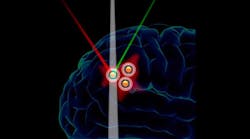Scientists at Memorial Sloan Kettering Cancer Center’s Kircher laboratory have developed a biomarker that adsorbs exclusively to the surface of cancerous cells in brain tumors. The technology is described as “theranostic” because the nanoprobes can be used for therapeutic purposes (surgery) as well as diagnostics, even in the early stages of cancer.
“We hope our technique will be helpful in showing surgeons exactly where the borders of the tumor are located,” says Dr. Moritz Kircher, who heads the lab. “It may also be useful in finding cancer cells that have spread away from the primary tumor site.” Kircher expects the study to lead to complete removal of brain tumors.
The nanoprobes have successfully been used in mice to generate high-resolution images of brain tumors using surface-enhanced Raman Spectroscopy (SERS). The report published in Nature Magazine claims that the SERS nanoprobes enable detailed imaging down to the tumor’s finger-like projections, which extend into the healthy tissue of the brain.
The nanoprobes are injected intravenously and bind to the tumor cells for imaging. They contain a layer of Raman-active material that, when hit with monochromatic light, emits light at a photonic wavelength longer than that of the incident light. The reduction in energy is due to inelastic scattering, or the loss of energy to interatomic vibrations. An extra layer enhances the signal so that the wavelength of emitted light can be processed by a computer database. The strength and orientation of the molecular bonds can then be determined to enable extremely precise and accurate imaging of the brain tumor at the molecular level.
Since the nanoprobes remain on the cells for a few days, they can be used for imaging before and during the surgery. They also can be excited by a light source to generate heat and, in turn, destroy malignant cells that cannot be removed surgically. They do not interrupt whole-body imaging techniques like MRI, PET, or CT, and are compatible for photoacoustic imaging to enable deep-tissue localization during surgery.

